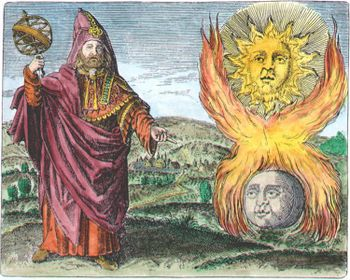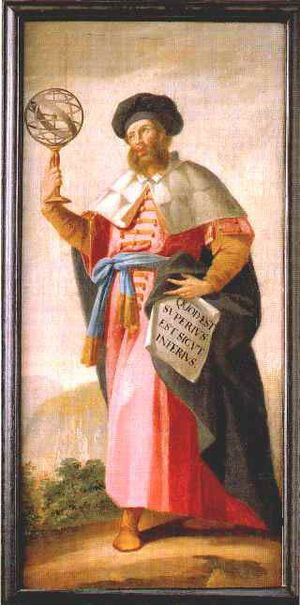Hermes Trismegistus


Hermes Trismegistus (Greek: Ἑρμῆς Τρισμέγιστος Hermes Trismegistos "thrice greatest Hermes"), the thrice great Thoth, was the inaugurator and teacher of Egyptian culture. Since ancient times, he was considered the author of the Corpus Hermeticum (also called Poimandres after first tractate in the Corpus Hermeticum), which, however, was probably only written down between 100 and 300 AD. The reference to Thoth-Hermes identifies him as an initiate of Mercury. The ancient sacred wisdom that he brought to the Egyptians is said to go back to that time, the three Sothis periods of 1460 years each, before the year 1322 BC, which marks the Exodus of Israel from Egypt, i.e. to the 6th millennium BC. (Lit.:GA 60, p. 369f) In this time, which lies long before the beginning of the Egyptian cultural epoch and even just before the ancient Persian time, falls the first work of Hermes. At that time, many people still had the brightest clairvoyance as a natural disposition. The dark Kali Yuga, with which this clairvoyance largely disappeared within a very short time, only began in 3101 BC, and the Egyptian cultural epoch, which only began in 2907 BC, was already completely immersed in this spiritual darkness. Only on a perilous path of initiation, which only a chosen few could tread, could the spiritual light still be found. This light, to which Hermes pointed the way, the essential spiritual Sun that would one day transform the Earth, is the Christ himself. Hermes pointed to him when he gave his wisdom teachings, which are recorded in the Tabula Smaragdina.
„But the one in whom the Egyptians saw, so to speak, all the original greatness of that ancient clairvoyant wisdom, they called their great sage, the ancient Hermes. When, at a later time, a renewer of the ancient Egyptian wisdom came, he called himself Hermes again - as did so many, in fact, according to an old custom of the Egyptian sages. And his confessors, because they said that the wisdom of Hermes, who had lived in the distant past, had been revived, now called this first Hermes the Thrice Great: Hermes Trismegistus. But basically only the Greek called him Hermes; among the Egyptians he had the name Thoth.“ (Lit.:GA 60, p. 351)
In order to be able to fulfil his task, Hermes in his Egyptian incarnation carried within himself the completely purified astral body of Zarathustra, whose disciple he had been in an earlier incarnation. While Moses, the second important disciple of Zarathustra, had become acquainted with the mysteries of time, Hermes was initiated by Zarathustra into the mysteries of space. Hermes continued in the Egyptian period the confrontation with the ahrimanic powers that Zarathustra had begun in the ancient Persian period. People were to learn to appreciate the physical world as a sensually visible script of the gods, as a hieroglyph of the spirit, and as their new field of activity. According to ancient Egyptian tradition, therefore, the Egyptian hieroglyphic script goes back to Hermes. Ahriman was to be overcome in the earthly world by incorporating the light laws of the starry world into dark matter. This was the basis for both the monumental architecture of the Egyptians and alchemy. Chemi or Kemi was also the name that the ancient Egyptians themselves gave to their country.
After Hermes, the secret knowledge, the knowledge of the supersensible world, is still called Hermeticism today. The most famous writing directly attributed to him, although its historical trace can only be traced back to the Middle Ages, is the Tabula Smaragdina, which is considered by alchemists to be the key to preparing the philosopher's stone.
Viewed spiritually, one can say that all the external skills that grew out of the original Hermetic teachings can be traced back to the grounding not only of the spiritual in the spiritual world, as was still the case in ancient Indian times, but the new element that was added by Hermes consisted in the unravelling of the divine work on the physical world. "It was shown on every part of the physical body to what spiritual work it corresponded [...]" (Lit.:GA 106, p. 117).
Literature
- Julius Ruska: Tabula smaragdina: ein Beitrag zur Geschichte der hermetischen Literatur. Carl Winter's Universitätsbuchhandlung, Heidelberg 1926 PDF with handwritten annotations (German)
- Rudolf Steiner: Antworten der Geisteswissenschaft auf die großen Fragen des Daseins, GA 60 (1983), ISBN 3-7274-0600-3 English: rsarchive.org German: pdf pdf(2) html mobi epub archive.org
- Rudolf Steiner: Ägyptische Mythen und Mysterien, GA 106 (1992), ISBN 3-7274-1060-4 English: rsarchive.org German: pdf pdf(2) html mobi epub archive.org
 |
References to the work of Rudolf Steiner follow Rudolf Steiner's Collected Works (CW or GA), Rudolf Steiner Verlag, Dornach/Switzerland, unless otherwise stated.
Email: verlag@steinerverlag.com URL: www.steinerverlag.com. Index to the Complete Works of Rudolf Steiner - Aelzina Books A complete list by Volume Number and a full list of known English translations you may also find at Rudolf Steiner's Collected Works Rudolf Steiner Archive - The largest online collection of Rudolf Steiner's books, lectures and articles in English. Rudolf Steiner Audio - Recorded and Read by Dale Brunsvold steinerbooks.org - Anthroposophic Press Inc. (USA) Rudolf Steiner Handbook - Christian Karl's proven standard work for orientation in Rudolf Steiner's Collected Works for free download as PDF. |
